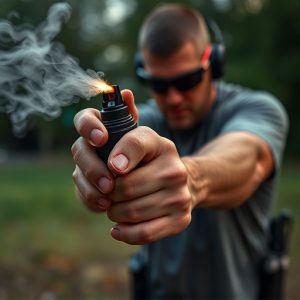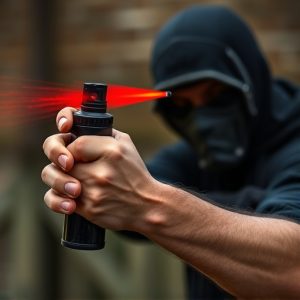Tactical Inflammatory Sprays: Bear vs. Pepper – Understanding Power Tools for Safety
Tactical inflammatory sprays, such as bear spray and personal pepper spray, offer non-lethal self-de…….
Tactical inflammatory sprays, such as bear spray and personal pepper spray, offer non-lethal self-defense solutions with distinct applications. Bear spray, designed for wildlife deterrence, has a long range and disrupts animal aggression, while personal pepper spray is potent against humans in close quarters, causing temporary blindness and respiratory distress. Both are valuable for outdoor activities, survival kits, and law enforcement, but their differences in range, potency, and target make them suited to specific self-defense needs and scenarios involving bears or human assailants. Proper training emphasizes safe use and effectiveness in diverse environments, ensuring users are prepared for unexpected encounters with these powerful tools.
“Tactical inflammatory spray systems are transforming personal defense, offering advanced protection against aggressive assailants. This comprehensive guide delves into the world of these powerful tools, focusing on key distinctions between bear spray and personal pepper spray. We explore their unique mechanisms, diverse applications, and critical safety aspects. By understanding the science behind inflammatory sprays, users can make informed choices, ensuring optimal performance during emergency situations. Navigate through our detailed sections for a complete overview.”
- Understanding Tactical Inflammatory Spray: A Comprehensive Overview
- Bear Spray vs. Personal Pepper Spray: Unraveling the Key Differences
- The Science Behind Inflammatory Sprays: How They Work
- Applications and Use Cases for Tactical Inflammatory Spray Systems
- Safety Considerations and Training for Optimal Performance
Understanding Tactical Inflammatory Spray: A Comprehensive Overview
Tactical inflammatory spray, also known as bear spray or personal pepper spray, is a powerful non-lethal self-defense tool designed to incapacitate an attacker temporarily. Unlike traditional pepper spray focused on the eyes and respiratory system, tactical inflammatory sprays are formulated to cause severe skin irritation, pain, and temporary blindness in close-range encounters. This difference is crucial when comparing bear spray vs personal pepper spray; while both serve as defensive measures, they target different threats. Bear spray is primarily used for animal deterrence, especially against bears, by creating a barrier of irritation around the user. In contrast, personal pepper spray is more versatile and commonly employed in close-quarters self-defense scenarios against humans.
A comprehensive understanding of tactical inflammatory spray involves recognizing its unique properties and application. The sprays typically contain capsaicin or similar irritants derived from chili peppers, ensuring a fast-acting response. Users are trained to aim for the face, eyes, and any exposed skin, as these areas are most susceptible to the spray’s effects. Proper usage requires quick reflexes and adherence to safety guidelines, such as avoiding inhalation and ensuring the wind blows away from the user after deployment. With their growing popularity in outdoor activities, survival kits, and personal protection, tactical inflammatory sprays offer a reliable solution for individuals facing unpredictable environments or potential physical threats.
Bear Spray vs. Personal Pepper Spray: Unraveling the Key Differences
When it comes to self-defense, Bear Spray and Personal Pepper Spray are two popular options, but they serve very different purposes. Understanding the key differences between them is crucial for choosing the right defense system. Bear spray, as the name suggests, is designed to deter bears, using a strong stream of capsaicin to irritate an animal’s eyes and nose, causing it to retreat. This spray is effective at long ranges, typically around 20-30 feet, and remains active for extended periods, making it ideal for outdoor activities in bear country.
On the other hand, Personal Pepper Spray (PPS) is tailored for human-to-human confrontations. It delivers a concentrated burst of capsaicin directly into the attacker’s eyes and face, causing temporary blindness and severe pain. PPS has a shorter effective range, usually around 3-5 feet, but it offers quicker reaction time and is more suitable for close-quarters defense scenarios. The potency and application method of these two types of sprays differ significantly, making Bear Spray vs. Personal Pepper Spray a key consideration when choosing a tactical defense system.
The Science Behind Inflammatory Sprays: How They Work
The Science Behind Inflammatory Sprays: How They Work
Inflammatory sprays, a powerful personal defense mechanism, harness the chemistry behind irritant chemicals to disrupt and disable assailants. At the heart of this technology lies capsaicin, the compound responsible for the heat and irritation in chili peppers. In these sprays, capsaicin is concentrated to create an intense reaction when inhaled by an attacker. This chemical irritates the eyes, nose, and respiratory system, causing temporary blindness, coughing, and difficulty breathing.
Unlike bear spray, which targets the animal’s senses to deter aggression, personal pepper spray focuses on human assailants. It’s designed to be non-lethal but highly effective in rendering an attacker temporarily incapacitated. The key difference lies in their applications: bear spray is used for wildlife encounters, while personal pepper spray is tailored for self-defense against humans, making it a more precise and targeted solution in urban settings.
Applications and Use Cases for Tactical Inflammatory Spray Systems
Tactical inflammatory spray systems, such as bear spray and personal pepper spray, offer a wide range of applications for self-defense, law enforcement, and military operations. Bear spray, designed to deter aggressive bears, is an effective long-range option, ideal for outdoor activities in bear country. It creates a barrier of capsicum oil, temporarily blinding and disorienting the animal, allowing individuals to escape safely. Personal pepper spray, on the other hand, is tailored for close-quarters self-defense against humans. This shorter-range spray delivers a powerful punch of capsaicin, causing temporary blindness, coughing, and respiratory distress in the assailant, giving the user valuable time to retreat or fight back.
Use cases extend beyond individual protection; these sprays can also be employed in crowd control scenarios by law enforcement agencies. The strategic deployment of tactical inflammatory spray systems enables authorities to manage high-risk situations, such as rioting or protest gatherings, by temporarily incapacitating multiple individuals simultaneously. This non-lethal approach is increasingly favored for its effectiveness and minimal harm to both parties involved, making it a valuable addition to modern law enforcement arsenals.
Safety Considerations and Training for Optimal Performance
When it comes to tactical inflammatory spray defense systems, safety considerations are paramount. Users must be properly trained to handle and deploy these powerful tools effectively while minimizing the risk of injury to themselves and others. A key distinction lies in understanding the differences between bear spray and personal pepper spray. Bear spray is designed to deter aggressive bears by causing temporary blindness and pain, but its range and potency make it suitable for outdoor, wildlife-related scenarios. In contrast, personal pepper spray is more commonly used for self-defense against humans, focusing on the eyes and respiratory system to disable an assailant temporarily.
Training should encompass not just the technical aspects of spraying but also scenario-based exercises that mimic real-life situations. This includes learning proper deployment techniques, understanding de-escalation strategies, and recognizing when and how to use the spray effectively while adhering to legal and ethical guidelines. Regular refresher courses are essential to maintain proficiency and ensure users are prepared for any unexpected encounters, enhancing overall performance in stressful situations.
Tactical inflammatory spray defense systems offer a versatile and powerful tool for personal safety, with distinct advantages over traditional bear spray and personal pepper spray. By understanding their unique properties and various applications, individuals can make informed decisions to enhance their protection in diverse scenarios. With proper training and safety considerations, these innovative sprays have the potential to revolutionize personal security, providing users with an effective and reliable defense mechanism. In choosing between bear spray vs. personal pepper spray, recognizing the specific needs of different situations is key, ensuring optimal performance and peace of mind.


